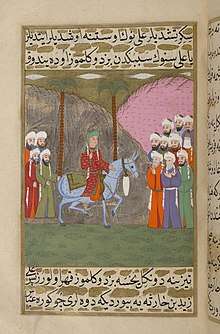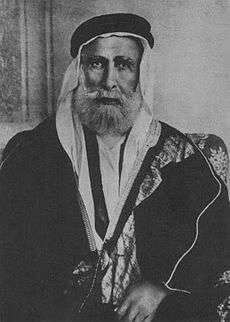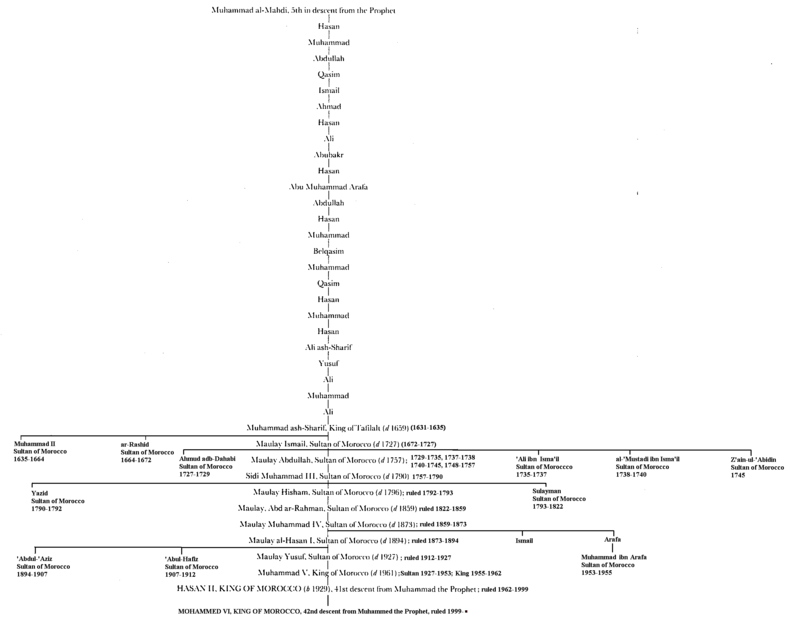Alids
Alvi or Alawi (Arabic: علوي, French: Alaouite) is an Arab community, found predominantly in the Arab world and the South Asian countries, Alawis are the one who were accepted as the descendants of Caliph Ali ibn Abi Talib, cousin and son-in-law of Muhammad, through his other wives, accept Fatimah.[1]:31 This title was later use by the Alawites and Qizilbash Alevis (who are not the descendants of Ali), they are naively from Syria and Turkey, As a proper noun it is used by individuals, dynasties, places, and religious sects and organizations who identify as being either descendants or followers of Ali, the Sunni Alevis are partially Hanafi and Maliki. The community are known as Alawi, Alevi, Alvi, Sayyid Alevi,[2]:149 Shah, Sain, Miya, Fakir, Dewan or Ansari (married with the descendants of Ansaris[3]:984). The descendants of Ali, who are from Fatimah are called Sayyid or Alevi Sayyid.
علوي | |
|---|---|
 'Ali, mounted on a blue mule, is approached by a delegation from the Quraysh tribe | |
| Regions with significant populations | |
| Arab world, Turkey, South Asia | |
| Languages | |
| Arabic, Turkish, Urdu | |
| Religion | |
| Islam |
| Part of a series on |
| Sunni Islam |
|---|
 |
In terms of Ihsan |
|
|
|
Lists |
|
|
| Part of a series on |
| Ali |
|---|
 |
|
Perspectives |
|
Related articles |
|

Lines of descent

Primarily Sunnis in the Arab world reserve the term sharif or "sherif" for descendants of Hasan ibn Ali, while sayyid is used for descendants of Husayn ibn Ali. Both Hasan and Husayn are grandchildren of Muhammad, through the marriage of his cousin Ali and his daughter Fatima. However ever since the post-Hashemite era began, the term sayyid has been used to denote descendants from both Hasan and Husayn. Arab Shiites use the terms sayyid and habib to denote descendants from both Hasan and Husayn; see also ashraf.
To try to resolve the confusion surrounding the descendants of Muhammad, the Ottoman Caliphs during the 19th Century C.E. attempted to replicate the Almanach de Gotha (the tome listing the noble houses of Europe) to show known and verifiable lines of descent. Although not 100% complete in its scope (some lines might have been excluded due to lack of proof, although no false lines are included) the resulting "Kitab al-Ashraf" (Book of the Sharifs), kept at the Topkapi Palace Museum in Istanbul is one of the best sources of evidence of descent from Muhammad.
There are several dynasties of Alid origin:
- Ali ibn Abi Talib
- Hasan ibn Ali
- Zayd ibn Hasan
- Hasan ibn Zayd of the Zaydid dynasty of Tabaristan (Alavids)
- Hasan ibn Hasan al-Mu'thannā
- Abd Allah al-Kāmil
- Musa al-Djawn
- Ibrahim
- Muhammad ibn Yusuf al-Ukhaidhir of the Ukhaydhirite dynasty of Al-Yamamah
- Ibrahim
- Musa al-Djawn
- Daud ibn Hasan
- Sulayman ibn Daud of the Sulaymanid dynasty of Yemen
- Ibrahim ibn Hasan
- Ismail ibn Ibrahim
- Ibrahim Tabataba ibn Ismail
- Qasim al-Rassi of the Rassid dynasty of Yemen
- Ibrahim Tabataba ibn Ismail
- Ismail ibn Ibrahim
- Abdallah ibn Hassan
- Djafar ibn Abdallah of the Sharifs of Sousse, Tunisia
- Muhammad ibn Abdallah of the Alaouite dynasty of Morocco
- Idris ibn Abdallah of the Idrisid dynasty of Morocco
- Sulayman ibn Abdallah of the Sulaymanid dynasty of, Tlemcen, Archgoul, Tenes (West-Algeria)[4]
- Musa ibn Abdallah
- Abdallah ibn Musa
- Musa ibn Abdallah ibn Musa
- Banu Qatadah/Hashemites
- Sharifs of Mecca
- Kings of Jordan
- Kings of Iraq
- Kings of Hejaz
- Kings of Syria
- Banu Qatadah/Hashemites
- Sulayman ibn Abdallah of the Sulaymanid Sharifs of Mecca
- Musa ibn Abdallah ibn Musa
- Abdallah ibn Musa
- Abd Allah al-Kāmil
- Zayd ibn Hasan
- Husayn ibn Ali of the Shia Imams
- Ismaili Imams
- Fatimids
- Nizari Imams
- Fatimids
- The Safavid dynasty claims descent from Husayn ibn Ali, sharing the first five original rulers with the Fatimids.[5] Many scholars have cast doubt on this claim, and there seems to be consensus among scholars that the Safavid family hailed from Persian Kurdistan.[6][7]
- Al Qasimi (Qawasim) dynasty of Sharjah and Ras al-Khaimah, claims descent from the 10th Imam, Ali al-Hadi.
- Ismaili Imams
- Hasan ibn Ali
Genealogical trees
This is a table of the interrelationships between the different parts of the Alid dynasties:[8]
| Family of Alids | |||||||||||||||||||||||||||||||||||||||||||||||||||||||||||||||||||||||||||||||||||||||||||||||||||||||||||||||||||||||||||||||||||||||||||||||||||||||||||||||||||||||||||||||||||||||||||||||||||||||||||||||||||||||||||||||||||||||||||||||||||||||||||||||||||||||||||||||||||||||||||||||||||||||||||||||||||||||||||||||||||||||||||||||||||||||||||||||||||||||||||||||||||||||||||||||||||||||||||||||||||||||||||||||||||||||||||||||||||||||||||||||||||||||||||||||||||||||||||||||||||||||||||||||||||||||||||||||||||||||||||||||||||||||||||||||||||||||||||||||||||||||||||||||||||||||||||||||||||||||||||||||||||||||||||||||||||||||||||||||||||||||||||||||||||||||||||||||||||||||||||||||||||||||||||||||||||||||||||||||||||||||||||||||||||||||||||||||||||||||||||||||||||||||||||||||||||||||||||||||||||||||||||||||||||||||||||||||||||||||||||||||||||||||||||||||||||||||||||||||||||||||||||||||||||||||||||||||||||||||||||||||||||||||||||||||||||||||||||||||||||||||||||||||||||||||||||||||||||||||
|---|---|---|---|---|---|---|---|---|---|---|---|---|---|---|---|---|---|---|---|---|---|---|---|---|---|---|---|---|---|---|---|---|---|---|---|---|---|---|---|---|---|---|---|---|---|---|---|---|---|---|---|---|---|---|---|---|---|---|---|---|---|---|---|---|---|---|---|---|---|---|---|---|---|---|---|---|---|---|---|---|---|---|---|---|---|---|---|---|---|---|---|---|---|---|---|---|---|---|---|---|---|---|---|---|---|---|---|---|---|---|---|---|---|---|---|---|---|---|---|---|---|---|---|---|---|---|---|---|---|---|---|---|---|---|---|---|---|---|---|---|---|---|---|---|---|---|---|---|---|---|---|---|---|---|---|---|---|---|---|---|---|---|---|---|---|---|---|---|---|---|---|---|---|---|---|---|---|---|---|---|---|---|---|---|---|---|---|---|---|---|---|---|---|---|---|---|---|---|---|---|---|---|---|---|---|---|---|---|---|---|---|---|---|---|---|---|---|---|---|---|---|---|---|---|---|---|---|---|---|---|---|---|---|---|---|---|---|---|---|---|---|---|---|---|---|---|---|---|---|---|---|---|---|---|---|---|---|---|---|---|---|---|---|---|---|---|---|---|---|---|---|---|---|---|---|---|---|---|---|---|---|---|---|---|---|---|---|---|---|---|---|---|---|---|---|---|---|---|---|---|---|---|---|---|---|---|---|---|---|---|---|---|---|---|---|---|---|---|---|---|---|---|---|---|---|---|---|---|---|---|---|---|---|---|---|---|---|---|---|---|---|---|---|---|---|---|---|---|---|---|---|---|---|---|---|---|---|---|---|---|---|---|---|---|---|---|---|---|---|---|---|---|---|---|---|---|---|---|---|---|---|---|---|---|---|---|---|---|---|---|---|---|---|---|---|---|---|---|---|---|---|---|---|---|---|---|---|---|---|---|---|---|---|---|---|---|---|---|---|---|---|---|---|---|---|---|---|---|---|---|---|---|---|---|---|---|---|---|---|---|---|---|---|---|---|---|---|---|---|---|---|---|---|---|---|---|---|---|---|---|---|---|---|---|---|---|---|---|---|---|---|---|---|---|---|---|---|---|---|---|---|---|---|---|---|---|---|---|---|---|---|---|---|---|---|---|---|---|---|---|---|---|---|---|---|---|---|---|---|---|---|---|---|---|---|---|---|---|---|---|---|---|---|---|---|---|---|---|---|---|---|---|---|---|---|---|---|---|---|---|---|---|---|---|---|---|---|---|---|---|---|---|---|---|---|---|---|---|---|---|---|---|---|---|---|---|---|---|---|---|---|---|---|---|---|---|---|---|---|---|---|---|---|---|---|---|---|---|---|---|---|---|---|---|---|---|---|---|---|---|---|---|---|---|---|---|---|---|---|---|---|---|---|---|---|---|---|---|---|---|---|---|---|---|---|---|---|---|---|---|---|---|---|---|---|---|---|---|---|---|---|---|---|---|---|---|---|---|---|---|---|---|---|---|---|---|---|---|---|---|---|---|---|---|---|---|---|---|---|---|---|---|---|---|---|---|---|---|---|---|---|---|---|---|---|---|---|---|---|---|---|---|---|---|---|---|---|---|---|---|---|---|---|---|---|---|---|---|---|---|---|---|---|---|---|---|---|---|---|---|---|---|---|---|---|---|---|---|---|---|---|---|---|---|---|---|---|---|---|---|---|---|---|---|---|---|---|---|---|---|---|---|---|---|---|---|---|---|---|---|---|---|---|---|---|---|---|---|---|---|---|---|---|---|---|---|---|---|---|---|---|---|---|---|---|---|---|---|---|---|---|---|---|---|---|---|---|---|---|---|---|---|---|---|---|---|---|---|---|---|---|---|---|---|---|---|---|---|---|---|---|---|---|---|---|---|---|---|---|---|---|---|---|---|---|---|---|---|---|---|---|---|---|---|---|---|---|---|---|---|---|---|---|---|---|---|---|---|---|---|---|---|---|---|---|---|---|---|---|---|---|---|---|---|---|---|---|---|---|---|---|---|---|---|---|---|---|---|---|---|---|---|---|---|---|---|---|---|---|---|---|---|---|---|---|---|---|---|---|---|---|---|---|---|---|---|---|---|---|---|---|---|---|---|---|---|---|---|---|---|---|---|---|---|---|---|---|---|---|---|---|---|---|---|---|---|---|---|---|---|---|---|---|---|---|---|---|---|---|---|---|---|---|---|---|---|---|---|---|---|---|---|---|---|---|---|---|---|---|---|---|---|---|---|---|---|---|---|---|---|---|---|---|---|---|---|---|---|---|
| |||||||||||||||||||||||||||||||||||||||||||||||||||||||||||||||||||||||||||||||||||||||||||||||||||||||||||||||||||||||||||||||||||||||||||||||||||||||||||||||||||||||||||||||||||||||||||||||||||||||||||||||||||||||||||||||||||||||||||||||||||||||||||||||||||||||||||||||||||||||||||||||||||||||||||||||||||||||||||||||||||||||||||||||||||||||||||||||||||||||||||||||||||||||||||||||||||||||||||||||||||||||||||||||||||||||||||||||||||||||||||||||||||||||||||||||||||||||||||||||||||||||||||||||||||||||||||||||||||||||||||||||||||||||||||||||||||||||||||||||||||||||||||||||||||||||||||||||||||||||||||||||||||||||||||||||||||||||||||||||||||||||||||||||||||||||||||||||||||||||||||||||||||||||||||||||||||||||||||||||||||||||||||||||||||||||||||||||||||||||||||||||||||||||||||||||||||||||||||||||||||||||||||||||||||||||||||||||||||||||||||||||||||||||||||||||||||||||||||||||||||||||||||||||||||||||||||||||||||||||||||||||||||||||||||||||||||||||||||||||||||||||||||||||||||||||||||||||||||||||
Below is a simplified family tree of Husayn ibn Ali. For the ancestors of ibn Ali see the family tree of Muhammad and the family tree of Ali. People in italics are considered by the majority of Shia and Sunni Muslims to be Ahl al-Bayt (People of the House). Twelver Shia also see the 4th to 12th Imamah as Ahl al-Bayt.
Family tree of Husayn ibn Ali
| Muhammad | Khadijah bint Khuwaylid | ||||||||||||||||||||||||||||||||||||||||||||||||||||
| Fatimah | Ali 1st Shia Imam 4th Rashidun Caliph | ||||||||||||||||||||||||||||||||||||||||||||||||||||
| Muhsin ibn Ali | Hasan ibn Ali 2nd Twelver/Zaidi and 1st Musta'li Imam | Husayn ibn Ali 3rd Twelver/Zaidi and 2nd Musta'li/Nizari Imam | Umm Kulthum bint Ali | Zaynab bint Ali | |||||||||||||||||||||||||||||||||||||||||||||||||
| Shahrbanu | Rubab bint Imra al-Qais | Layla bint Abi Murrah al-Thaqafi | Umm Ishaq bint Talhah | ||||||||||||||||||||||||||||||||||||||||||||||||||
| Fatima Sughra | Sakinah bint Husayn | Ali al-Asghar ibn Husayn | Sukayna bint Husayn | Ali al-Akbar ibn Husayn | Fatimah bint Husayn | ||||||||||||||||||||||||||||||||||||||||||||||||
| Mother of ‘Umar | Ali ibn Husayn 4th Twelver/Zaidi and 3rd Musta'li/Nizari Imam | Fatimah bint al-Hasan | Jayda al-Sindhi | Ali al-Akbar ibn Husayn | |||||||||||||||||||||||||||||||||||||||||||||||||
| ‘Umar al-Ashraf | Muhammad al-Baqir 5th Twelver and 4th Musta'li/Nizari Imam | Farwah bint al-Qasim (Umm Farwa) | Zayd ibn Ali 5th Zaidi Imam | Ali al-Asghar ibn Husayn | |||||||||||||||||||||||||||||||||||||||||||||||||
| ‘Alī | Hamidah Khatun | Ja'far al-Sadiq 6th Twelver and 5th Musta'li/Nizari Imam | Fatima bint al-Hussain'l-Athram bin al-Hasan bin Ali | Zaynab bint Husayn | |||||||||||||||||||||||||||||||||||||||||||||||||
| al-Ḥasan | Musa al-Kadhim 7th Twelver Imam | Abdullah al-Aftah ibn Ja'far al-Sadiq | Isma'il ibn Jafar 6th Musta'li/Nizari Imam | Unknown | Umm Kulthum bint Husayn | ||||||||||||||||||||||||||||||||||||||||||||||||
| ‘Alī | Ummul Banīn Najmah | ||||||||||||||||||||||||||||||||||||||||||||||||||||
| al-Nāṣir al-Kabīr | Ali ar-Ridha 8th Twelver Imam | Sabīkah a.k.a. Khayzurān | Muhammad ibn Ismail 7th Sevener/Musta'li/Nizari Imam | Fatima | |||||||||||||||||||||||||||||||||||||||||||||||||
| Sumānah | Muhammad al-Taqi 9th Twelver Imam | Unknown | Ahmad al-Wafi 8th Musta'li/Nizari Imam | Other issue | |||||||||||||||||||||||||||||||||||||||||||||||||
| Ali al-Hadi 10th Twelver Imam | Hâdise (Hadīthah) / Suzan (Sūsan) / Sevil (Savīl) | Other issue | Muhammad at-Taqi 9th Musta'li/Nizari Imam | Unknown | |||||||||||||||||||||||||||||||||||||||||||||||||
| Hasan al-Askari 11th Twelver Imam | Narjis | Rabi Abdullah 10th Musta'li/Nizari Imam | |||||||||||||||||||||||||||||||||||||||||||||||||||
| Muhammad al-Mahdi 12th Twelver Imam | |||||||||||||||||||||||||||||||||||||||||||||||||||||
Family tree of Hasan ibn Ali
The Hashemites of Sharifs of Mecca, Kings of Jordan, Syria and Iraq are descended from the other brother Hasan ibn Ali:
The Alaouites, Kings of Morocco, are also descended from the other brother Hasan ibn Ali through Al Hassan Addakhil:
Genealogoical chart of the descent from Muhammad of the Idrisid dynasty, rulers of Fez and Morocco, Kings of Tunis, and the Senussi dynasty, founders and heads of the Libyan Senussi Order and Kings of Libya are also descended from the other brother Hasan ibn Ali through Al Hassan Addakhil.
See also
- Descendants of Ali ibn Abi Talib
- Family tree of Ali
- Family tree of Muhammad
- Family tree of Husayn ibn Ali
- Genealogy of Khadijah's daughters
- Kaysanites Shia
References
- Parwej, Mohammad Khalid (2015). 365 days with Sahabah. Goodword Books. Retrieved 4 July 2017.
- Ho, Engseng (2006). The graves of Tarim genealogy and mobility across the Indian Ocean. Berkeley: University of California Press. ISBN 978-0-520-93869-4. Retrieved 25 August 2016.
- K. S. Singh, People of India Uttar Pradesh, Volume XLII Part Two. Manohar Publications
- Ibn Khaldoun, Histoire des Berbères, 2003, Berti, Alger.
- Kathryn Babayan, Mystics, Monarchs and Messiahs: Cultural Landscapes of Early Modern Iran, Cambridge, Massachusetts ; London : Harvard University Press, 2002. p. 143: "It is true that during their revolutionary phase (1447-1501), Safavi guides had played on their descent from the family of the Prophet. The hagiography of the founder of the Safavi order, Shaykh Safi al-Din Safvat al-Safa written by Ibn Bazzaz in 1350-was tampered with during this very phase. An initial stage of revisions saw the transformation of Safavi identity as Sunni Kurds into Arab blood descendants of Muhammad."
- R.M. Savory, "Safavid Persia" in: Ann Katherine Swynford Lambton, Peter Malcolm Holt, Bernard Lewis, The Cambridge History of Islam, Cambridge University Press, 1977. p. 394: "They (Safavids after the establishment of the Safavid state) fabricated evidence to prove that the Safavids were Sayyids."
- RM Savory, Safavids, Encyclopedia of Islam, 2nd ed.
- Daftary, Farhad. "ʿAlids." Encyclopaedia of Islam, THREE. Edited by: Gudrun Krämer, Denis Matringe, John Nawas, Everett Rowson. Brill Online, 2014.
- Al-Yasin, Shaykh Radi. "1". Sulh al-Hasan. Jasim al-Rasheed. Qum: Ansariyan Publications. p. 4.
- Madelung, "Al-Ukhaydir," p. 792
- The Hashemites: Jordan's Royal Family
- Stitt, George (1948). A Prince of Arabia, the Amir Shereef Ali Haider. George Allen & Unwin, London.
- Bosworth, Clifford Edmund (1996). The New Islamic Dynasties. Edinburgh University Press.
- Antonius, George (1946). The Arab Awakening. Capricorn Books, New York.
- The Hashemites, 1827-present
- "Morocco (Alaoui Dynasty)". Usa-morocco.org. Archived from the original on 2005-08-29. Retrieved 2014-01-01.
- Montgomery-Massingberd, Hugh (1980). Burke's Royal Families of the World: Africa & the Middle East. Burke's Peerage.
